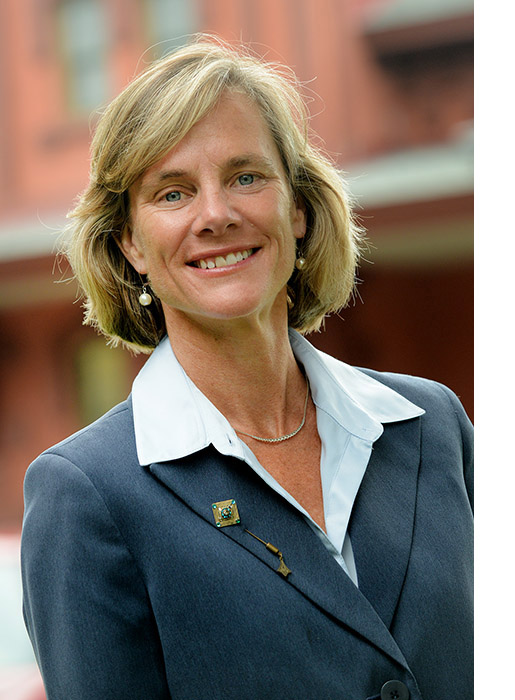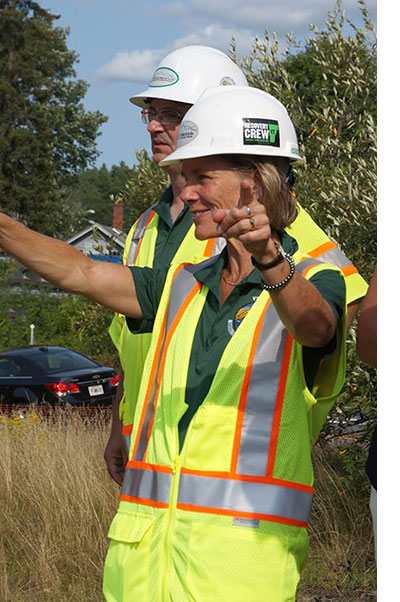Sue Minter Throws Her Hat in the Ring |
|||
| by Renée Carpenter | |||
|
It takes a unique person to leave an excellent and secure job that one loves and does well to take the risk of running for public office. That’s exactly what Sue Minter did in early September when she left her well-earned position as Vermont’s secretary of transportation. With the encouragement of family and friends—including former secretary of human services Doug Racine and former governor Madeline Kunin—Minter worked with the Shumlin administration to find her replacement. And then she announced her candidacy for governor, jumping into a field of Democratic candidates that will face off in the Vermont Democratic primary election next August. The official kick-off event for Sue Minter’s gubernatorial campaign was held Tuesday, October 6, in front of the historic train station across from the Waterbury green. As a friendly crowd slowly gathered on a perfect, cool, mostly sunny fall day, Minter spoke with press, campaign volunteers, and posed for a few photos, the collar and sleeves of her crisp white shirt framing a bright service-blue blazer. Several individuals with familiar faces from state government, nonprofits, and other community organizations, along with curious individuals wondering, “Who is Sue Minter,” moved about or mingled in small groups. Duncan McDougal—well known for his work as the executive director of the Children’s Literacy Foundation and chair of Waterbury LEAP—opened the event highlighting the excitement of having the first gubernatorial candidate from Waterbury in 125 years. McDougal called it “entirely appropriate” for the initial kick-off event to take place “in front of our beautiful historic train station, a great example of downtown revitalization work that Sue has been a part of here in Waterbury and all across the state; and emblematic of the innovative partnerships that communities can forge.” |
||
Minter has lived in Waterbury Center for 25 years. She has been publicly active in the community from volunteering in the schools, to serving as a board member of the Children’s Room and the Waterbury Planning Commission, working with Revitalizing Waterbury to rebuild its downtown, and representing Waterbury in the legislature for six years (2004–2010). Doug Racine—former Vermont secretary of human services, a former lieutenant governor, and former state senator—spoke of Minter as “the most qualified candidate” with a value system of care and compassion. “She cares about Vermont and her children, especially those in families who are struggling; she understands the impacts of poverty on those families.” Racine said, “I share her vision of a Vermont where kids grow up to be happy and healthy, can get a good education . . . so they can be productive citizens when they grown up; part of an economy that works for every Vermonter and not just a privileged few.” Also standing with Minter was former governor Madeleine Kunin. Kunin, introduced as “the first, and so far only, woman governor Vermont” (1985–1991), said that Minter “has the passion and enthusiasm” to run and “is more than qualified” to be the next woman governor of Vermont. “She will carry the torch for every single one of us because that is her value system,” Kunin said, calling Minter “the most qualified to be governor regardless of gender” to whom she would like to pass the proverbial torch of women’s leadership. Minter stepped up to the podium and began by thanking her husband, David Goodman, and her two children, Jasper (15) and Arial (23), calling them her “inspiration for wanting to make the world a better place.” “I am running for governor because where I see problems, I also see potential,” Minter said. “I believe that our moments of greatest challenge are also our moments of greatest opportunity.” Minter touched upon “the foundation for a strong economy” and the policy issues and considerations that she’ll tackle as governor—many of which she has already been working on in her other official capacities. What most people know about Sue Minter stems from her leadership role as the “Queen of Irene.” When Tropical Storm Irene tore through Vermont on August 28, 2011, damaging countless homes and ravaging Vermont’s roads, bridges, and communities, Minter was the deputy secretary of the Agency of Transportation. As deputy secretary, Minter’s explicit focus was to rebuild Vermont’s infrastructure in the shortest time possible: to assess the damage and human need and to prioritize levels of urgency. Within the first 24 hours, VTrans completely reorganized and restructured itself and redeployed key people into the hardest hit areas, called “incident command centers.” Minter was positioned in Montpelier, called “the unified command.” “Our role was to set up the structure, deploy our people, build the teams, and then to really direct, at the top of the organization, the goals and priorities; to make sure everything was moving expeditiously, and to trouble shoot every challenge that came along,” explained Minter. With the state emergency operation center flooded, along with the rest of the State Office Complex in Waterbury, communication was essential: From the unified command to the incident command centers, Minter’s network of responsibility included 700 people on the ground out in the areas of greatest impact; plus utility companies, contractors, National Guard troops from all around the country; and community leaders and volunteers. Minter needed to communicate with everyone involved in the recovery operations, including the newly organized multiagency state team and also with the general public. Minter explained, “We set very clear goals and measured ourselves against those goals and made sure we met every one of those goals. Our final goal was to make certain that every road was at least maintainable for winter. There were people cut off all over the state. We opened up the final mile of damaged road at the end of December.” After observing Minter’s skill, energy, commitment, and effective leadership in a crisis—over 500 miles of road, 34 state bridges, and hundreds of local bridges in the four months leading into winter—Governor Shumlin appointed Minter to serve as “Irene Recovery Officer” (as Lunderville stepped down). The focus shifted from transportation infrastructure to housing: 3,500 homes were damaged, people needed ways to rebuild, and FEMA—the Federal Emergency Management Agency—presented many challenges. Minter worked with individuals to restore their homes, and with businesses and community leaders in towns that were devastated by the flooding, including her hometown of Waterbury. Minter asked, “How were we going to help people to rebuild?”—not if it was possible—and didn’t take no for an answer when up against challenging bureaucracies. She explained, “[W]e were in the midst of trying to help the mobile home [owners] get the allowance for condemnation,” and “working very closely with FEMA . . . pushing FEMA to make sure they were giving the maximum that every individual could receive.” Minter’s nonstop activity included negotiations with state and federal agencies, seeking support and resources wherever necessary including Vermont’s Congressional delegation. From Montpelier to Washington, DC, and traveling throughout Vermont, Minter met with individuals, business owners, and community leaders to listen, assess, and resolve problems. When asked about her unflagging energy, Minter reflected back: “It was the economic impact; it was farms, river restoration. There were very many issues that we had to be dealing with all at once and in a very rapid-fire fashion.” Minter was able to accomplish these enormously challenging tasks with grace and alacrity. Under her leadership, the infrastructure devastated by Irene was repaired ahead of schedule and under budget. The effectiveness of her work to rebuild communities gained her the appointment as secretary of the Vermont Agency of Transportation (January 2015), the second largest state agency in Vermont with a budget of over $600 million.
She also believes “we have to address the shocking level of income inequality and to develop pathways out of poverty through education, workforce training and jobs” and often illustrates her belief in the strong role of government investment in people and communities by pointing out the role of federal, state, and local governments in partnership with local businesses and private investments in the recovery after the disaster of Irene. Developing resilience in the face of climate change to Minter means community and social investment that rebuilds communities, strengthens our schools and the economy, and creates jobs. Finally, Minter has repeatedly responded that Act 46—the 2015 education law that applies spending caps and compels school districts to consolidate—must be “reviewed” and likely modified so that it supports excellence in education and more local control over budgets. At a recent Democratic rally, Minter highlighted the threat of national political trends and influence as “the voices of ‘no.’” Minter said, “I am concerned. I hear the voices of ‘no’ growing louder. Those voices . . . are connected to that national chorus that says, ‘No, we can’t take care of senior citizens—it’s not our responsibility. We can’t afford to keep our schools thriving. We can’t afford to take care of access to health care or address climate change.’ I would say this: We can’t afford not to. Not when we have 20,000 children living in poverty in Vermont today. Not when we have a third of our female-headed families living in poverty today. Not when opiates are affecting every community in Vermont, in this state today.” Minter also inferred that national forces support Republican governorships. “We have Republican governors in Maine, Massachusetts, New Jersey, and in Maryland. We cannot afford to return to the past,” she said. |
|||
|
Renée Carpenter has lived in central Vermont for more than 25 years working as an educator, radio news and commentary producer, organic landscape and market gardener, freelance editor and writer, and community activist involved with issues of environmental protection and social and economic justice.
|
||

